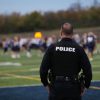For Sheldon Greenberg, the most important fact about school violence is one that many people don’t expect to hear. “Schools are safe,” he says. “Period. They are about the safest place you can be in this country on any given day.”
That fact, backed by multiple data points indicating a decline in school crime over the past 25-plus years, was one of the guiding perspectives brought to light during “School Resource Officers and School Violence,” a talk he presented last month as part of the Johns Hopkins Center for Safe and Healthy Schools’ inaugural lecture series.
Greenberg, a Johns Hopkins School of Education professor associated with the center, came armed with a formidable arsenal of information to provide perspective on what he characterizes as a “really complex, confusing topic.”
Recent data from the National Safety Council and the Centers for Disease Control and Prevention, for example, put the chance of dying in a school shooting at 1 in 3 million. Meanwhile, one in three parents worry that their children face danger in school on a daily basis, based on National Center for Education Statistics data.
In this fraught environment—where fear of harm is sometimes greater than actual harm—approximately 42 percent of schools have invested in school resource officers (SROs), most often local or state law enforcement officers who are assigned to schools, largely without school input.
Little research has been done on the effectiveness of SROs in reducing crime in schools, including school violence. Only 12 states require SRO training, and funding for these positions is often grant-dependent, thereby difficult to sustain. Some evidence points to the presence of police in schools as adversely impacting minority students and actually contributing to a “school-to-prison pipeline.”
While he sees much potential value in the collaboration of schools with law enforcement officers, Greenberg thinks we have a long way to go as a society in realizing broader school and community safety and wellness.
“We cannot look at school security or safety in a vacuum, as we are doing consistently,” he says. “We have to recognize it in terms of the overall well-being of the school and its community.… which means we have to do a lot more than we’re doing right now.”
Greenberg’s talk was the fourth in the Center for Safe and Healthy Schools lecture series, which is woven into the coursework for all students in counseling, teaching preparation, special education, and school administration. In total, the five lectures are the core teaching units of the School of Education’s safe and healthy schools curriculum.
The series wraps up on February 20 with a final lecture by Assistant Professor Richard Lofton on race, place, and systemic inequalities.

